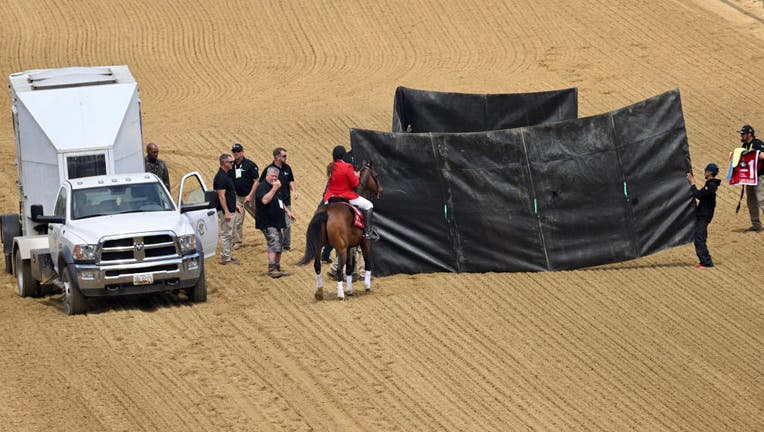US horse racing deaths slightly up in 2023, report shows despite safety efforts

Bob Baffert-trained horse and favorite Havnameltdown, behind the curtain, had to be euthanized Saturday, May 20, 2023, during the sixth race of Preakness Day at Pimlico Race Course in Baltimore. (Jerry Jackson/Baltimore Sun/Tribune News Service via G
Deaths from horse racing in the U.S. have been slightly on the rise between 2022 and 2023, according to the annual report released Wednesday by the federally mandated agency that began regulating the sport two years ago.
The Horse Racing Integrity and Safety Authority said 1.32 deaths per 1,000 starts last year, up from 1.25 tracked by the Equine Injury Database the previous year. The number at the 50 HISA-accredited tracks had a rate of 1.23 per 1,000 compared to 1.63 at others across the country.
While up from 2022, the 1.32 deaths per 1,000 starts is still the second-lowest equine fatality rate since they started being tracked in 2009, down from the previous lows of 1.39 in 2021 and 1.41 in '20.
"Our inaugural annual report reflects our journey toward a safer, fairer and more resilient future for horse racing," CEO Lisa Lazarus said in a statement accompanying the report. "The success of HISA’s programs relies on steady partnership among the tracks, trainers, riders, owners, veterinarians and state regulators who comprise the sport. Only by working together can we make thoroughbred racing safer for its equine and human athletes."
Racetrack safety oversight began in July 2022 by the HISA, including anti-doping measures.
Spates of deaths at Churchill Downs in Louisville around the Kentucky Derby and at New York's Saratoga Race Course last year thrust the sport into the spotlight for all the wrong reasons. Churchill Downs suspended racing in June after 12 horses died there, prompting an emergency summit with industry leaders before resuming in the fall, and a New York Racing Association investigation into 13 racing or training deaths at Saratoga found no definitive cause, though significant rainfall "could not be overlooked" as a contributing factor.
In a message published in the report, Lazarus pointed to national, uniformed practices such as pre-race veterinary inspections, treatment records that follow horses throughout their careers, the availability of full medical and workout histories and reporting of racetrack surface conditions as improvements that have been instituted.
"I feel much optimism about the strides we will continue to make by recognizing that protecting the health and safety of our horses and jockeys is a collective, urgent, responsibility," Lazarus wrote.
A message sent to the National Thoroughbred Racing Association seeking comment by the Associated Press on the report was not immediately returned.
The Associated Press contributed to this report. This story was reported from Los Angeles.

